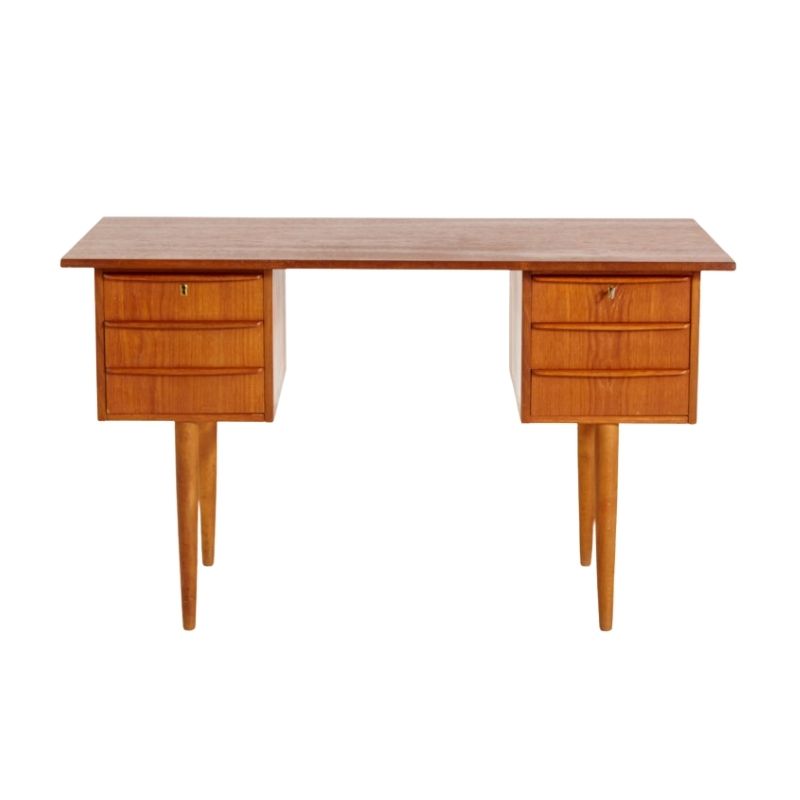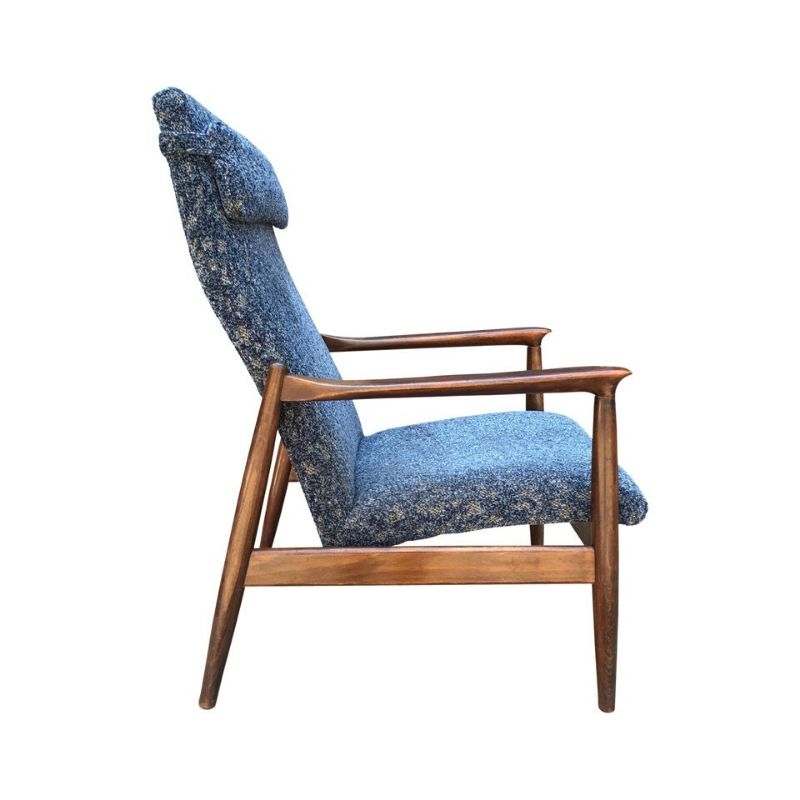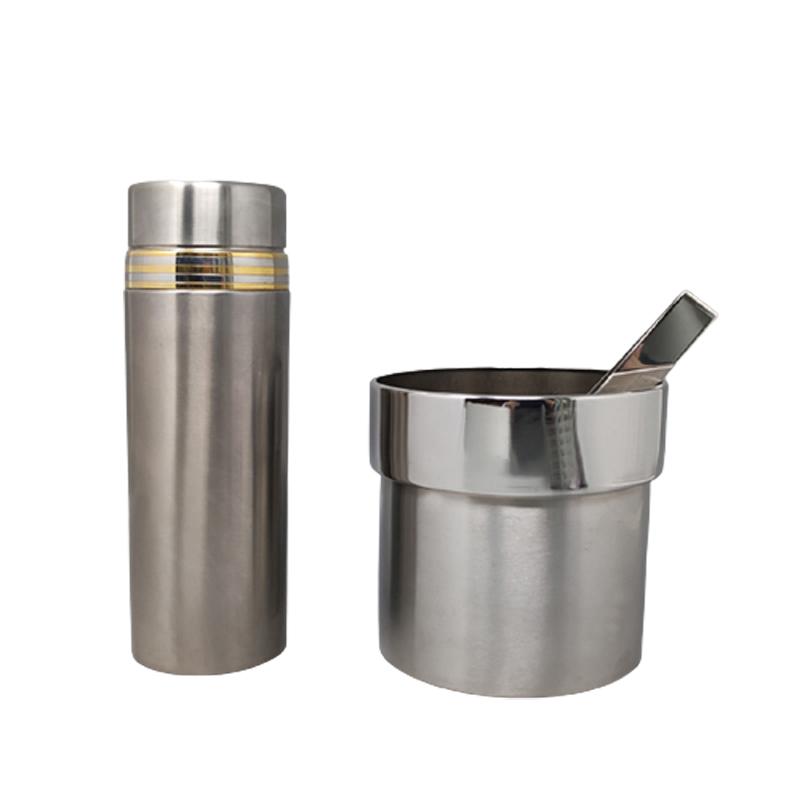This morning I began to dissect the binding cane on the backs of one of my Peter Hvidt armchairs to try to figure out how the weaving was done.
The 500 pixel image below is kind of small, so there is a larger version at the linked URL that shows more detail.
Basically, what I have found so far is that the individual sections of horizontal weaving look like the section that corresponds to what I have labeled as "A" and "B". This represents a single continuous piece of binding cane, that has both of its tag ends tucked under its own wrapping, to secure them (see image).
The thing is, I cannot quite figure out what method was used in order to get both ends tucked under. If you started wrapping on side "A", you can easily enough wrap right over the top of the tag end, securing it, which is simple enough to understand, but when you finish the wrap on side "B", I am not sure how it was done.
I initially assumed that a long tag end would have been threaded under the loose wraps, then pulled by hand to make everything taut. Then, you could trim this long tag end off by slicing it carefully by running a razor between the wraps. But, I see no evidence that it was done this way, as the blunt cut ends of the rattan do not correspond to their having been sliced off like that. Nor are there any telltale horizontal cut marks on the frame of the chair itself.
I figure there must be a tool or technique that I am not aware of for pulling the tag end under the wraps. Any suggestions?


Very interesting. I'd also b...
Very interesting. I'd also be curious how this is done and to hear about your experience with cane moving forward. I have a pair of Selig Kofod Larsen chairs with cane backs that have some breaks....am thinking of repairing but am hesitant to jump in.
I see now that there is a...
I see now that there is a pattern of tool marks on the wood of the chair frame, which seem to correspond to the angle at which the tag ends of the rattan were cut off. These scratches only occur on one side of the chair frame, so I assume that it was on that side that the wrapping was completed, and the tag end pulled under the wraps and trimmed off.
If these scratches indicate the use of a tool to trim off the tag end of the rattan while it was under the wraps, I have no idea what kind of tool this would be...
The book I have on chair weaving has a section on rattan for Danish chairs, but it makes extensive use of small nails to secure the tag ends of wraps, rather than this tucked-under method that my Hvidt chairs utilize.
Perhaps one just slips a...
Perhaps one just slips a thin knife blade under the wraps, then pulls the long tag end of the rattan back against it, slicing it off under the wraps...
Doing this weaving job would be a lot of work, so I am still kind of hoping that I can find out the actual way it was done for certain, to lessen the risk that I end up having something go wrong, and have to re-do the entire thing.
This website shows the...
This website shows the manner in which I initially thought the tag end of the rattan was trimmed off from under the wraps - using a razor knife to cut it between the wraps as seen in pic #7. However, my Hvidt chairs were not done in this manner, and while I could do it this way, I would still prefer to know how it was done originally.
http://www.vikingsword.com/vb/showthread.php?t=2701
At this point I am pretty sure it was some kind of specialized cutting blade, but so far I have not been able to find any examples of a tool like that.
http://www.vikingsword.com/vb/showthread.php?t=2701
Are you sure that that's the same strand
of cane, with each end tucked under in the same manner?
Could it be two different strands, with their other ends secured in a different way that isn't obvious without undoing the weaving and wrapping?
I ask because I just redid some rattan seats with wrapped rails and it took me for-freaking-EVER to figure out where to stop and start and how the ends were concealed. I spent a lot of time studying the original weave & wrapping while carefully undoing it. Finally I gave up and started doing the closest approximation that i could and in doing that I finally stumbled upon the right way.
I knew it was something very simple, it just wasn't very obvious.
On your chair it's hard to tell where the strand stops and starts because there are a lot of breaks. I would start by assuming that they used less than a full length before tucking the end in and starting a new one.
It's also possible to allow a little slack when weaving, thus giving you some room to work an end in---because the cane is soaked for 1/2 hour in hot water first, so it is expanded a bit in addition to being softened and less likely to break. But it's still stiff enough that you can easily work an end under some wrapped strands if necessary. Then it dries and tightens up really nicely!
Thanks Spanky,I have...
Thanks Spanky,
I have dissected a lot of the horizontal wraps, and they are all the same as the one I illustrated in the photo, where it begins with six wraps on one side of the chair, and then completes with six wraps on the other side of the chair, always done with a single continuous piece of rattan, with its tag ends tucked under in an identical manner on both the left and the right sides.
Most of the breaks in the rattan in the photo are where I cut the rattan intentionally, and unwrapped it. The rattan actually had relatively few breaks to start out with, but was old and fragile enough that I knew it needed to be redone. So, the breaks and missing sections are mostly all places where I was dissecting the chair. In doing so, I found that the basic horizontal unit of weaving was the one I illustrated with six wraps at "A", and then crossing over to six wraps at "B". Each time one of these horizontal units is completed using a single strand of rattan, a new, identical one is done beneath it, which partially overlaps onto the prior one. So, with my chair they started the horizontal wraps at the very top, and worked their way down to the bottom.
OK, gotcha---
so then my next guess would be that the end of the strand is trimmed and tucked under the slightly-slack wraps, and once the cane dries it is all very snug and taut. Then it's hard to see how that end was stuck in there because once dry, it's in there really tight. Does that make sense?
Cane is cheap, so feel free to mess around with some. It might be more obvious once you are actually doing it.
Wraps and distances
So the first piece of cane goes across and then gets wrapped five times wraps below below. And the next piece of cane goes across two wraps below the first. Which means the second cane is covering the bottom three wraps of the first.
This seems odd to me, but seems an inevitable conclusion from the photo.
And it means that the bottom three wraps and tag end don't have to be incredibly tight since the next cane down will squeeze them tight.
So imagine:
-Start on the left with the tag end wrapped tight under the wraps since you can go over it as you wrap up.
-Go across and wrap down
-Insert needle under you bottom wraps, which will loosen them just a bit. (This leaves a slight scrape mark in the wood). And slide the tag end under beside the needle.
-Start the next cane on the right, since this is the beginning you can get the tail very tight. And it will go over the bottom slightly loose wraps of the last cane.
In this way you can proceed tight start of the new cane over loose end of the old cane, without wasting time pulling and cutting the ends.
I think that is the trick.
Yes, each subsequent course...
Yes, each subsequent course of 6 wraps does cover the bottom 3 from the prior course, just as you observed.
It is possible that the tag end is simply pulled tight and then tucked under the wraps with the help of a needle-like tool, as you suggested. Using a pair of pliers to pull on a short tag end of the rattan, you probably could get it quite tight, then pinching the rattan against the side of the chair frame to hold it in place, you could quite possibly manage to tuck the end under the other wraps, securing it all. It is certainly worth giving that a try, as it is the most straightforward method, as you and Spanky said.
The scrapes do resemble what a large needle would make.
I am finding that weaving a...
I am finding that weaving a chair with rattan is a lot more tedious and slow-paced than doing a typical paper cord seat. A lot more breaks in the rattan, defects that make you start a wrap over again with a new piece of rattan, and there is just a lot more general busywork than working with paper cord.
After fully removing the old rattan from my first chair, I saw that it appears to have been woven by two different people on the production line. One used the method of tucking the cane under, whereas the other used only nails, which is what I have opted to do, and have found works just fine. If one had mastery of a method of tucking the tag ends under, it would be a time saver, but nailing the ends works just as well for securing the ends until the next course is wrapped over them.
I will probably not work on this any more until I get some more free time to do it. There are a few hours left on it.
Ooo, nice!
Regarding breaks---are you weaving with the grain of the cane? You have to look at the nodes very carefully and also just run a finger across them. They're a little rougher in one direction than the other and you have to lead with the end that runs in the smooth direction. Otherwise the roughness catches on other cane and can snap after a bit.
Also, are you soaking it for 30 minutes in hot water first? I figured out a really good trick with soaking. I found that if i just leave it in the water, it turns gray after awhile (like for an hour or more, as I weave---I just wanted to keep it wet so that it stayed soft.) BUT, if I took it out, some strands would be dried out again by the time I was ready to weave with them. Either way I was screwed.
So finally--like way after I should have thought of it---i figured out that I could soak a whole bunch for exactly half an hour, then take it out and shake off the excess water then put all but a few strands into a plastic bag and fold the opening shut. Then I just pulled out a strand or two at a time. It would stay damp for hours but did not turn gray from soaking too long. Kind of a perfect solution.
Cane that is too dry will break a lot more easily than damp cane, btw.
Thanks Spanky. I will pay cl...
Thanks Spanky. I will pay closer attention to the grain direction, and remember now you mentioned that before. So far I have had some cane turn gray from soaking, but so far it seems to always dry out and turn light colored again. I will try the bag technique to not risk ending up with some cane staying gray.
The gray on mine
went away to a degree but not completely. It's subtle but it bugged me. Maybe it has to do with qualities of the local tap water? I dunno. But even if it weren't an issue, I like keeping the soaked cane in plastic. If nothing else, I get the drippy phase out of the way in the beginning so no worries about drops of water on the chair frame.
If you need any help, please contact us at – info@designaddict.com









